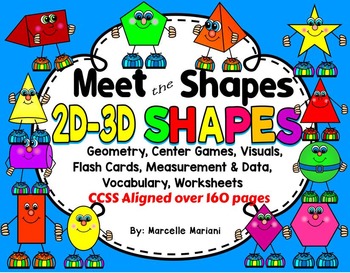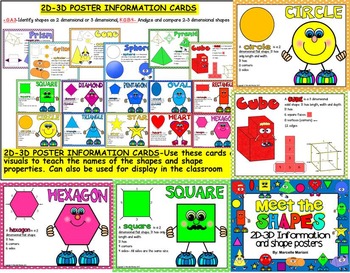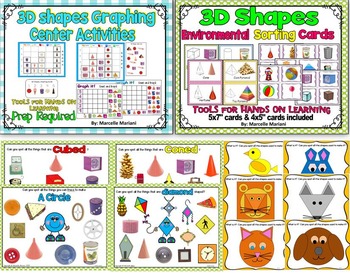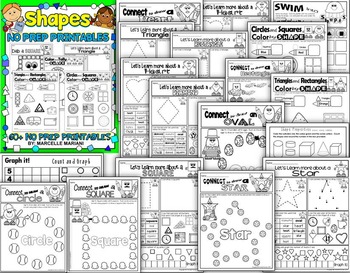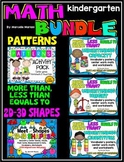2D and 3D Shapes Pack,Geometry unit, Center Games, Flash Cards, Worksheets, CCSS
- Zip
What educators are saying
Also included in
- This bundle pack is over 500 pages of Math and Geometry teaching resources and covers More than-less than (quantities, capacity and weight), patterns and 2D and 3D shapes. PLEASE REFER TO THE LINKS BELOW TO VIEW EACH OF THESE PACKETS INDIVIDUALLY AS I WAS UNABLE TO INCLUDE ALL THE TOOLS IN THE THUMBPrice $12.99Original Price $24.98Save $11.99
Description
This 160+ pages of resources is a 2D- 3D shapes BUNDLE that includes 2d-3d shapes worksheets, graphing, center tools, posters and flash cards. This unit delivers all the CCSS Geometry objectives for KG and is suitable for Kindergarten to Grade 1 students.
NOTE: THIS PACKAGE IS AVAILABLE AS A PART OF A MEGA MATH BUNDLE (2D-3D shapes, Patterns, More than less than). CLICK THE LINK TO CHECK IT OUT.
Link- MEGA MATH BUNDLE-2D-3D, PATTERNS, MORE THAN-LESS THAN
This set provides clear visuals and hands on experiences to teach the concept of 2 dimensional and 3 dimensional shapes.
SOME OF THE TOOLS IN THIS PACKAGE ARE LISTED SEPARATELY AND CAN BE VIEWED AT THESE LINKS (THIS IS ONLY SOME OF WHAT IS INCLUDED IN THIS PACK- MANY THINGS IN HERE ARE NOT SOLD SEPARATELY AND ARE ONLY AVAILABLE AS A PART OF THIS PACKAGE)
2D-3D SHAPES INFORMATION AND VOCABULARY POSTERS
3D SHAPES ENVIRONMENTAL SORTING CARDS
3D SHAPES GRAPHING CENTER ACTIVITIES
NOTE: I do my best to strive for positive ratings. If there are any concerns with this product, PLEASE CONTACT ME FIRST AT MARCELLEMARIANI@GMAIL.COM. I will ensure that you are absolutely 100% satisfied with your purchase.
Here's what's included:
1. 2D and 3D Shapes–Information-Vocabulary cards-Visuals
Targeted Objectives:
a.(K.G.A.3)-Identify shapes as 2 dimensional or 3 dimensional
b.(K.G.B.4)–Analyze and compare 2-3 dimensional shapes
Includes:
A. (6) 3D Full size information-Vocabulary cards
B. (7) 2D Full size information-Vocabulary cards
C. (6) 3D Shape character vocabulary flash cards
D. (7) 2D Shape character vocabulary flash cards
E. (11) 2D shape pictures-Flash cards
F. (8) Black and white shape pictures-To be used as coloring
sheets *in the worksheets folder
G. (1) 2D Definition Flash Information card
H. (1) 3D Definition Flash Information card
Use these cards as visuals to teach the names of the shapes and shape properties (2D/3D, numbers of sides, and number of corners).
Use these cards for display– on boards and as visuals of 2-3D shapes.
Use the 2 D shape pictures as a group game to get children to discuss what they see, what shapes the picture is composed of, how many shapes, what colors?
Included are also black and white shape coloring sheets– You can have children choose their own colors or color according to the colored flash card model.
2. Sorting Environmental Cards 4”x6”with 3D shape comparison
Targeted Objectives:
a. (K.G.A.3)-Identify shapes as 2 dimensional or 3 dimensional
b. (K.G.B.4)–Analyze and compare 2-3 dimensional shapes
c.(K.G.A.2)– Correctly name shapes regardless of orientation and size
d.(K.G.A.1)–Describe objects on the environment using names of shapes.
Includes:
A. (16) Environmental comparison cylinder cards 4’x6’
B. (14) Environmental comparison cube cards 4’x6’
C. (14) Environmental comparison cone cards 4’x6’
D. (10) Environmental comparison pyramid cards 4’x6’
E. (6) Environmental comparison sphere cards 4’x6’
Use these cards to make direct comparison between the shape and the object reflecting on specific properties (number of sides, number of faces, vertices, if the object rolls or slides)
3. Sorting Environmental Cards 13cmx11cm
Targeted Objectives:
a. (K.G.A.3)-Identifying shapes as 2 dimensional (plane) or 3 dimensional (solid)
b. (K.G.B.4)-Analyze and compare 2-3 dimensional shapes
c. (K.MD.A.1)-Describe measurable attributes of objects such as length or weight of a single object.
d.(K.MD.A.2)-Directly compare two objects with a measurable attribute in common (more than, less than, taller/shorter).
e.(K.MD.B.3)-Classify objects into given categories; count the number in each category and sort categories by count.
Includes:
A.(72)- Environmental small cards showing items in the environment.
B.(7)- 3D Shape title cards
These cards are designed for young children to identify 3D shapes in real life objects. Here are some suggestions:
Use these cards during group discussion times to talk about the shapes and to compare the shapes to each other– this means identifying similarities and differences in their structure (K.M.D.A.1)
You can place the title cards and have children sort the pictures by shapes. (k.MD.A.1)
You can have children count the shapes after they are all sorted in a row or column and identify which shape has more image/pictures (K..MD.B.3)
Use these cards on a display/teaching board
You can use the title cards as headings to sort real objects you have in class or in the house (K.MD.A.1) and you can extend that by asking children to count how many of each shape we have at home/in class (K.MD.B.3)
4. 3D shapes– Graphing
These cards are designed for young children to identify 3D shape and interpret data to graph and sort 3D and 2D objects
Targeted Objectives:
a.(K.G.A.3)-Identifying shapes as 2 dimensional (plane) or 3 dimensional (solid).
b. (K.MD.B.3)-Classify objects into given categories; count the number in each category and sort categories by count.
c.(K.CC.B.4c)-Understand that each successive number refers to a larger quantity.
d.(K.CC.A.4a)-When counting objects–Say the number names int the standard order pairing each object one object.
e.(K.CC.B.5)-Count to answer “how many” about items arranged in a line, circular order, rectangular array or scattered.
f.Interpret data, problem solving and follow written instructions
Includes:
A. (1)-Generic graph-Color-(1-5) where children interpret data from a 3D data card and graph accordingly (5 cards+75 graph cards)
B. (1)-Graph-Black and white- (1-5)- Printer friendly
C. (1)-Graph- Adaptable to 1-10 (Color)
D. (1)-Graph-Adaptable to 1-10 (Black and white)
E. (20)-Graph cards (numbers 1-20)
F. (30)-Graph 3D cards
G. (5)-3D shapes data cards
H. (75)-Small graph 3D cards to go with the data cards
I. (6)-3D graphing guide cards
J (60)-Small graph 3D cards t go with graphing guide
Graphs are adaptable to be used with real objects- Print and copy as needed.
5. Environmental comparison cards 8.5x11
A.(6)-Large 8.5 x 11 comparison cards/mats-Color
Use these cards as during group lessons/discussions about shapes– Ask children to identify and compare the shapes on the cards . Every card targets a different shape– children need to locate all the items on the card that are the same shape as the one in the circle.
These can also be used as work mats– laminate and use a board marker to have children circle the shapes-Great center activity for younger children
6. 3D Shape Nets
A. (1)-Net information definition/information card
B. (2)-Net to shape identification visual mats–problem solving
C. (1)-Net to shape identification visual display/teaching mat
D. (6)-Reproducible Shape nets–To assemble 3D shapes
Children can assemble the nets and compare them to each other and real objects
Children can make multiples of each net and use them to build larger shapes and structures (taller cylinders and cube towers)
7.Worksheets
A. (16) different worksheets to target understanding 2D and 3D shapes

